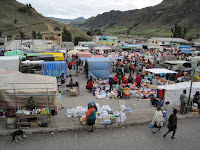So what´s the food like? Let´s start with the staples- corn and potatoes. That´s really what it´s all about here. The upside is that there´s a lot you can do with corn and potatoes. Other staples are platanos (bananas and plantains), yuca, rice, pork, chicken, and of course the meat Ecuador is most famous for, cuy (guinea pig). Note: I haven´t tried cuy, but Kurtis has, and he described it as ¨different, yet also not that different¨.
Fruits are also big here, mainly in jugo (juice) form. Highlights that we don´t have in the US are naranjilla, maracuya (passion fruit), guanabana (soursop), taxo, granadilla, and tomate de arbol.

Lunch seems to be the big deal here. Most typical restuarants offer almuerzos, or set lunches, that will set you back $1.50- $4.00. They usually include juice, soup, a main dish, and something sweet.
Some typical dishes here are:
Caldo de Pollo (chicken soup)
Caldo de Pata (calf´s foot soup)
Sopa de Quinoa (Yum!)
Seco de Chivo/Pollo (rice with goat/chicken)
Fritada (to be explained below)
Locro (cheese and potato soup with avocado- also yum)
llapingacho (fried potato and cheese patties- obviously yum)
empanadas
hornado (a whole roast pig- I saw this in the market, crazy!)
Our school offers a cooking class, and we attended one where we made fritada. It consists, first and foremost, of fried pork. I think you could say it is deep fried pork. Then you take some cooked potatoes, mix them with some cheese and achiote (a vegetable used to dye food red), form them into tortillas, and fry those. Then you take some ripe plaintains and fry those, too. This is all served with mote, which is white corn that´s cooked until it bursts, similar to hominy. (Our class also made a salad, but I´m pretty sure that was just for appearances sake)
Fritada
 Most of the food here is not spicy, but every meal is served with aji. Aji is a salsa made with the aji pepper (a pepper that grows here in the andes) and the tomate de arbol fruit. Tomate de arbol (or tree tomato) tastes nothing like a tomato, apparently. It is a not-too-sweet fruit that you can eat raw, cooked, or in juice form (I´ve only had it in aji form).
Most of the food here is not spicy, but every meal is served with aji. Aji is a salsa made with the aji pepper (a pepper that grows here in the andes) and the tomate de arbol fruit. Tomate de arbol (or tree tomato) tastes nothing like a tomato, apparently. It is a not-too-sweet fruit that you can eat raw, cooked, or in juice form (I´ve only had it in aji form).Snacks! They have a great snack here- ceviche de chocho. Chocho is a legume that we don´t have in the US, and it´s delicious. This is served with deep fried corn kernels. If you go for the full on ceviche, it is mixed with tomato
 sauce, lime, red onions, and if you´re lucky, some homemade potato chips. Because the majority of it is chocho, it´s actually pretty healthy.
sauce, lime, red onions, and if you´re lucky, some homemade potato chips. Because the majority of it is chocho, it´s actually pretty healthy.Another snack is cafe con humitas or quimbolito- ground corn steamed in a leaf wrapper, tamale-style, but sweet. Then they have yogurt and pan de yuca- your choice of exotic fruit-flavored, liquidy yogurt served with little pieces of bread made from yuca.
Also, popcorn is often served with soup- just throw it on in there!
Since this week is Holy Week, we got to try a Quiteño specialty- Fanesca. Fanesca is a crazy fish soup that is only made once a year. It contains, well, basically everything. It is made with twelve types of grains (to represent the twelve apostles) including a few types of beans, lentils, peas, chocho etc., and also fish, milk, potatoes, pumpkin. Then it is topped with queso, an empanada, bolitos (little fried balls of dough), fried banana, onion, and parsley. Fish is, thankfully, the only meat due to the fact that it is eaten during Lent. Ecuadorian families traditionally prepare this together, and Ecuadorian families are large, so it is made in batches meant to serve over 100 people. We helped to prepare it at our school and made 150 servings!
And finally- drinks. A traditional Ecuadorian drink is canelazo. It´s a hot alcoholic drink made with fruit juice (the place we went had either mora (blackberry) or naranjilla) and aguardiente (alcohol made from sugar cane). Really, really delicious. Other than that, they have two types of beer and one of them, Pilsener, is not half bad.
And that´s it for the food in Quito! The next report will be on Jungle food- stay tuned.



























